Dracup Surname Ancestry ResultsOur indexes 1000-1999 include entries for the spelling 'dracup'. In the period you have requested, we have the following 33 records (displaying 1 to 10): Single Surname Subscription | | | Buying all 33 results of this search individually would cost £162.00. But you can have free access to all 33 records for a year, to view, to save and print, for £100. Save £62.00. More... |
These sample scans are from the original record. You will get scans of the full pages or articles where the surname you searched for has been found. Your web browser may prevent the sample windows from opening; in this case please change your browser settings to allow pop-up windows from this site. Inhabitants of Bolton-le-Moors in Lancashire
(1790-1797)
The provincial sections of the Universal British Directory include lists of gentry and traders from each town and the surrounding countryside, with names of local surgeons, lawyers, postmasters, carriers, &c. (the sample scan here is from the section for Bath). The directory started publication in 1791, but was not completed for some years, and the provincial lists, sent in by local agents, can date back as early as 1790 and as late as 1797.
DRACUP. Cost: £6.00.  | Sample scan, click to enlarge

| Manchester Directory
(1825)
W. Parson compiled this Manchester trades directory included in the second volume of the History, Directory, and Gazetteer of the County Palatine of Lancaster, by Edward Baines, published in 1825. The names are arranged alphabetically by surname and christian name, with address, including house numbers where appropriate.DRACUP. Cost: £4.00.  | Sample scan, click to enlarge

| Electors for Horton
(1848)
On 14 and 15 December 1848 an election took place for a Knight of the Shire for the West Riding of Yorkshire in the House of Commons. The candidates were Edmund Denison and sir Culling Eardley Eardley, gaining 14,743 and 11,795 votes respectively. The county franchise at this period included freeholders of land worth 40s or more a year; £10 copyholders and long-leaseholders; and £50 short-leaseholders and tenants. This poll book was published in 1849.
Former poll books had been compiled from the sheriff's returns; but as these were now transmitted to the Home Office immediately after an election, in this instance the polling was marked from the check-clerk's returns, carefully compared with the registers marked in the poll booths at the time of voting.
The votes for the respective candidates are indicated by the numerals 1 (Denison) and 2 (Eardley). The omission of these numerals indicates that the elector did not vote. Many names which appear on the register of particular townships are completely omitted in this poll book: in all these cases, the same name will be found recorded in some other township, the elector having two or more qualifications. In such cases, his name only appears in the poll book in the actual township for which he chose to vote; or, if he did not vote at all, in that township for which he was qualified that lay closest to his actual residence.
The townships are arranged alphabetically within polling district; and within each township the names are arranged alphabetically by surname and christian name, and the elector's residence is given. Many of the electors resided outside the township for which they were qualified - some in other counties. Moreover, at the end of each polling district there is a list of persons registered to poll in that district, from townships is other districts. DRACUP. Cost: £6.00.  | Sample scan, click to enlarge
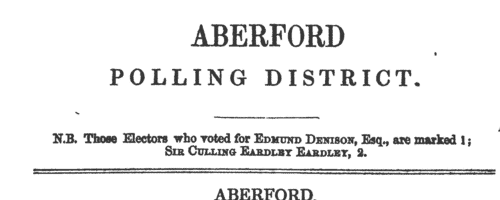
| Anglican Schoolmasters
(1850)
The Committee of Council on Education awarded certificates of merit to teachers throughout Britain, and published annual lists of those qualifying in the previous years. Masters and mistresses are listed separately, with surname and initials, and school at which teaching, post town or county, and grade of the certificate: each of the three classes of certificate being subdivided into three. There are five separate lists for masters and mistresses:
1. Teachers in schools in connexion with the Church of England; male students in the Training Schools of the National Society, and of the several Diocesan Boards of Education; and female students in the Training Schools of the National Society (Whitelands, Chelsea), the Home and Colonial School Society (Gray's Inn Road, Holborn), and the Salisbury and York and Ripon Diocesan Boards of Education.
2. Teachers, in England and Wales, of British, Wesleyan and other Protestant Schools, not in connexion with the Church of England;
3. Teachers, in England and Wales, of Roman Catholic Schools;
4. Teachers of schools in Scotland, in connexion with the Established Church; male students in the Edinburgh and Glasgow Training Colleges; and female students in training schools.
5. Teachers of schools in Scotland, not in connexion with the Established Church; male students in the Training Schools of the Free Church (at Edinburgh and Glasgow); and female students in training schools.
This is the list, corrected to 1 January 1851, published in 1851.DRACUP. Cost: £4.00.  | Sample scan, click to enlarge
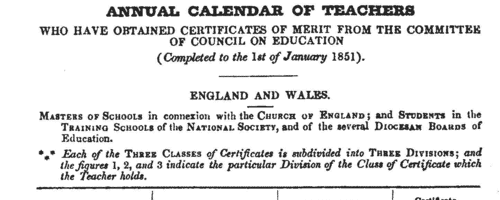
| Inhabitants of Bradford, Yorkshire
(1853)
William White's directory lists traders, farmers and private residents in the area.DRACUP. Cost: £6.00.  | Sample scan, click to enlarge
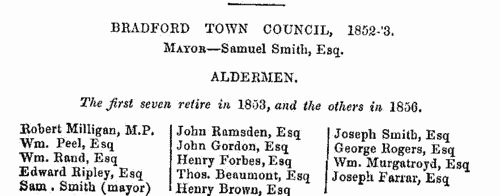
| Schoolmasters and trainees with Certificates of Merit
(1856)
The Committee of Council on Education for England and Wales produced an annual report which included several lists of teachers and trainee teachers, including an Annual Calendar of Teachers who have Obtained Certificates of Merit (completed to 1 January 1856), from which this sample scan is taken. The teachers are listed alphabetically by surname and initial, with name of school, post town or county, and grade, as either certificate or class. Student teachers were classed at the end of each year of training, so the column for class shows a student's class (1, 2 or 3) at the end of their first or second year of training. The teacher may then be awarded a certificate of merit by Her Majesty's Inspector, in which case the class and division of the certificate awarded appears in the columns for Certificate. No certificate of merit was granted a student, as a teacher, until he or she had been for two years in charge of the same elementary school, and the certificate was granted on the basis of two reports of performance as a teacher in school. If the first report was favourable, the teacher was paid for the first year on the scale of the lowest class; if the second report was favourable, augmentation and class of certificate was fixed for the next five years, after which (and so on from time to time) the certificates were open to revision. The value of the certificate, in the first instance, was not fixed higher than the first division of the third class, for any student who had resided less than two years at a training school under inspection. This is the index to the schoolmasters and male students in training schools. DRACUP. Cost: £6.00.  | Sample scan, click to enlarge

| Patentees of New Inventions
(1862)
Abstracts of British patents for new inventions applied for and granted from 1 January to 31 December 1862: giving date, name and address, and short description of the invention. It is then stated whether 'Letters patent sealed' or 'Provisional protection only'.DRACUP. Cost: £6.00.  | Sample scan, click to enlarge
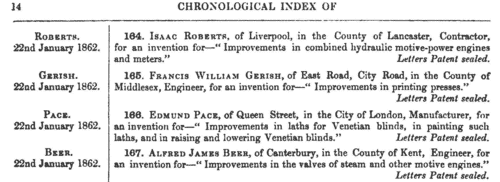
| Pupil Teachers training to become Schoolmasters
(1875)
The Education Department set examinations for candidates for admission into training colleges, and to become teachers. This is the class list (in order of merit) of the men who took that examination at Christmas 1875, and who were awarded Second Class results. The first column gives the position in the exam results (no number is inserted where the candidate obtained the same marks as the last to whose name a number is prefixed); then there is the candidate's name (surname first); school in which engaged (N. for National School, Ch. Church of England, B. British School, W. Wesleyan, R. Roman Catholic, P. Parochial, Bd. Board School, U. Poor Law Union School); and then Training College at which examined. (The sample scan is from a general class list for schoolmistresses)DRACUP. Cost: £6.00.  | Sample scan, click to enlarge
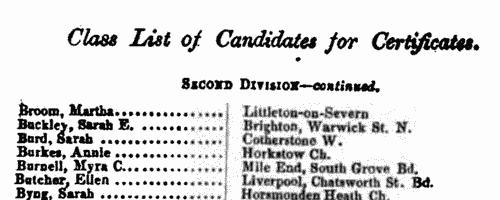
| Baptists
(1876)
The Baptist was a weekly newspaper, with some general news and political coverage, but mainly devoted to chronicling Denominational Intelligence, i. e. the doings of the Baptist churches in Britain and Ireland. January to June 1876.DRACUP. Cost: £6.00.  | Sample scan, click to enlarge
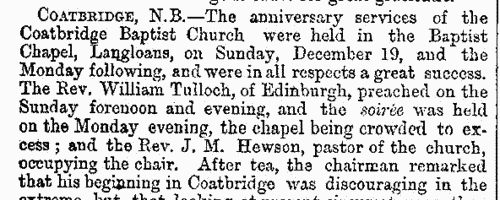
| Bankrupts, Assignees, Trustees and Solicitors
(1881)
Bankruptcy notices in England and Wales, January to March 1881DRACUP. Cost: £6.00.  | Sample scan, click to enlarge

|
Research your ancestry, family history, genealogy and one-name study by direct access to original records and archives indexed by surname.
|












